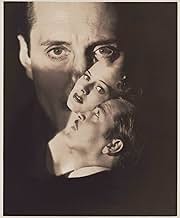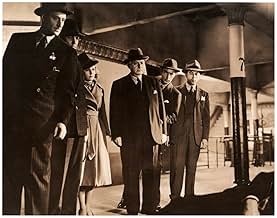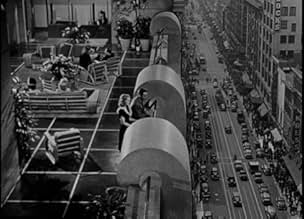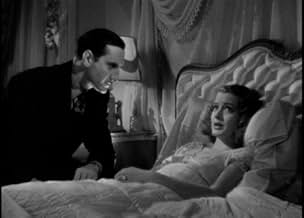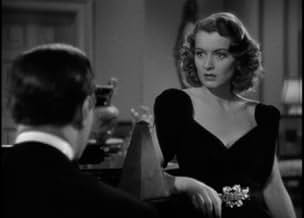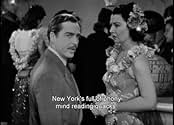Füge eine Handlung in deiner Sprache hinzuA crazed physician marries a wealthy women and, with the help of his demented assistant, murders them for their money.A crazed physician marries a wealthy women and, with the help of his demented assistant, murders them for their money.A crazed physician marries a wealthy women and, with the help of his demented assistant, murders them for their money.
Barbara Jo Allen
- Louise Watkins
- (as Barbara Allen [Vera Vague])
Bobby Barber
- Bald Man in Library
- (Nicht genannt)
William 'Billy' Benedict
- Mickey Barnes - Copy Boy
- (Nicht genannt)
George Chandler
- Elevator Operator
- (Nicht genannt)
Edward Earle
- Librarian
- (Nicht genannt)
Chuck Hamilton
- Police Officer at Train Station
- (Nicht genannt)
Sam Harris
- Passerby
- (Nicht genannt)
Harry Hayden
- Ticket Clerk
- (Nicht genannt)
Douglas Kennedy
- Hotel Clerk
- (Nicht genannt)
Settar Körmükçü
- Dr. David Profesor
- (Nicht genannt)
John Laing
- Intern
- (Nicht genannt)
Empfohlene Bewertungen
The story begins with the deaths of one of Sebastian's wives. Her father is convinced that Sebastian is responsible...and during much of the film he works to bring the man to justice. But to counter the father, Sebastian has Gretz steal the body of his latest victim in order to prevent an autopsy! What else will these infamous killers do next?
Basil Rathbone plays the suave Bluebeard who uses his hypnotic powers over women, Dr. Sebastian. He marries rich women, murders them and then disappears....off to find another woman to kill. He's assisted in his endeavors by Gretz...and their relationship is VERY unusual (and nowadays it would be seen as homoerotic by many). I would love to see a remake that explores this odd relationship more. Regardless, it is an interesting little suspense picture...well worth seeing because of the acting and script.
Basil Rathbone plays the suave Bluebeard who uses his hypnotic powers over women, Dr. Sebastian. He marries rich women, murders them and then disappears....off to find another woman to kill. He's assisted in his endeavors by Gretz...and their relationship is VERY unusual (and nowadays it would be seen as homoerotic by many). I would love to see a remake that explores this odd relationship more. Regardless, it is an interesting little suspense picture...well worth seeing because of the acting and script.
I remember seeing THE MAD DOCTOR on TV back in the early 1960s and although I didn't see it again until the release of this Blu-Ray half a century later, parts of it, especially the ending, had remained with me. Why this film has not made its bow on home video until now is beyond me. It's an A Movie, as can be seen by the big budget, but with B Movie sensibilities regarding its use of character players outside of Rathbone and its overall Film Noir look which is due to cinematographer Ted Tetzlaff. Even the title sounds like a B Movie. However the strongest element in the whole mix is the screenplay. More about that later.
The plot concerns a suave Svengali-like psychiatrist played by Rathbone who marries wealthy women and then disposes of them. He meets a wealthy socialite who has suicidal tendencies (Ellen Drew) and plans to make her his next victim. Can her reporter boyfriend (John Howard), whom she has rejected, save her in time? Nothing out of the ordinary there. What IS different in THE MAD DOCTOR is the relationship between Rathbone and his constant companion played by Martin Kosleck. It is clearly a gay relationship in everything but name and how it got past the 1940 censors is a question worth asking.
The screenplay was originally written by top writers Ben Hecht & Charles MacArthur in the early 1930s and intended for John Barrymore (hence the Svengali angle). It was originally called "The Monster" and later "Destiny". That explains the quality dialogue which is one of the movie's highlights. When Barrymore bowed out, the script sat on the shelf for 5 years before Paramount used it. They had changes made by Howard W. Green who received sole screen credit. Although full of dark moments, there is a lightness of touch from director Tim Whelan which adds to the enjoyment. Kino deserves credit for resurrecting this forgotten gem. Once you see it, you'll wonder why it stayed hidden for so long...For more reviews visit The Capsule Critic.
The plot concerns a suave Svengali-like psychiatrist played by Rathbone who marries wealthy women and then disposes of them. He meets a wealthy socialite who has suicidal tendencies (Ellen Drew) and plans to make her his next victim. Can her reporter boyfriend (John Howard), whom she has rejected, save her in time? Nothing out of the ordinary there. What IS different in THE MAD DOCTOR is the relationship between Rathbone and his constant companion played by Martin Kosleck. It is clearly a gay relationship in everything but name and how it got past the 1940 censors is a question worth asking.
The screenplay was originally written by top writers Ben Hecht & Charles MacArthur in the early 1930s and intended for John Barrymore (hence the Svengali angle). It was originally called "The Monster" and later "Destiny". That explains the quality dialogue which is one of the movie's highlights. When Barrymore bowed out, the script sat on the shelf for 5 years before Paramount used it. They had changes made by Howard W. Green who received sole screen credit. Although full of dark moments, there is a lightness of touch from director Tim Whelan which adds to the enjoyment. Kino deserves credit for resurrecting this forgotten gem. Once you see it, you'll wonder why it stayed hidden for so long...For more reviews visit The Capsule Critic.
1940's "The Mad Doctor" is a sadly generic but wholly appropriate title for this Paramount feature, one of their rare genre efforts (working titles "The Monster" and "A Date with Destiny"). In the title role of Dr. George Sebastian, Basil Rathbone is not a 'mad doctor' as in 'mad scientist,' but a psychotic faux psychiatrist living with partner Maurice Gretz (Martin Kosleck), both wanted for murder in Vienna, having relocated to America. With the sudden demise of Sebastian's third wife, he takes up residence in New York City, where he begins another practice, meeting up with potential wife number four, hypochondriac Linda Boothe (Ellen Drew), whom Maurice believes would be the perfect candidate due to her suicidal tendencies (that would save them the trouble of bumping her off). Lurking in the background is Dr. Charles Downer (Ralph Morgan), a longtime friend of Sebastian's late wife, whose suspicions about her untimely death are soon confirmed, at his peril. This Ben Hecht story is loaded with promise, yet fudges its attempts at suspense with sketchy characterizations, virtually none of whom engender any sympathy, particularly the heroine, apparently as dim as the scatterbrained sister (Barbara Allen) that introduced her to Dr. Sebastian. The binding relationship between the doctor and Maurice is by far the most intriguing aspect to the film, but little footage is devoted to their villainy, the pace slowed to a crawl by endless romantic twaddle. The final third almost makes up for all these faults, but the excellent cast is left pretty much on their own. Ellen Drew was much better, and far more sympathetic, in another Paramount, "The Monster and the Girl," while Martin Kosleck easily steals his scenes from the rather surprisingly uninspired Rathbone (much better in "Kind Lady"), soon to enjoy one of his finest villains opposite Tyrone Power in "The Mark of Zorro."
Basil Rathbone stars with Ellen Drew in The Mad Doctor from 1940.
Rathbone plays a psychiatrist, George Sebastien, who is a black widower, marrying women for their money and then killing them. The last time, the doctor in charge of his wife's case (Ralph Morgan) is suspicious, but Sebastien convinces his assistant (Martin Kosleck) that the old man is harmless. As usual, they pick up stakes, this time moving to New York City.
Sebastien becomes aware of a beautiful young woman, Linda Boothe (Drew) who is depressed and suicidal. He agrees to take her case.
Her boyfriend (John Howard) doesn't believe in psychiatry and wants to discredit him. As a reporter, he writes a series of negative articles.
The problem here is that Howard takes such an instant dislike to the doctor that it just comes off as jealousy. However, Sebastien does get to the reason for Linda's problems - her own father's suicide - and helps her.
Sebastien has actually fallen for Linda and believes he has been cured of his desire to kill. That apparently arose from his first wife cheating on him.
This is a very entertaining if strange film. One wonders about the relationship between Sebastien and his assistant, who is furious that Sebastien wants to marry Linda and stop killing.
Rathbone is terrific - romantic, charming, and evil. Drew is a lovely actress and ideal in her role. Martin Kosleck as the bizarre assistant is just right.
Recommended. Rathbone is always good.
Rathbone plays a psychiatrist, George Sebastien, who is a black widower, marrying women for their money and then killing them. The last time, the doctor in charge of his wife's case (Ralph Morgan) is suspicious, but Sebastien convinces his assistant (Martin Kosleck) that the old man is harmless. As usual, they pick up stakes, this time moving to New York City.
Sebastien becomes aware of a beautiful young woman, Linda Boothe (Drew) who is depressed and suicidal. He agrees to take her case.
Her boyfriend (John Howard) doesn't believe in psychiatry and wants to discredit him. As a reporter, he writes a series of negative articles.
The problem here is that Howard takes such an instant dislike to the doctor that it just comes off as jealousy. However, Sebastien does get to the reason for Linda's problems - her own father's suicide - and helps her.
Sebastien has actually fallen for Linda and believes he has been cured of his desire to kill. That apparently arose from his first wife cheating on him.
This is a very entertaining if strange film. One wonders about the relationship between Sebastien and his assistant, who is furious that Sebastien wants to marry Linda and stop killing.
Rathbone is terrific - romantic, charming, and evil. Drew is a lovely actress and ideal in her role. Martin Kosleck as the bizarre assistant is just right.
Recommended. Rathbone is always good.
Doctor Ralph Morgan calls at Basil Rathbone's home. His patient, Rathbone's wife, has died. Morgan is suspicious; she was recovering. He does nothing about it.
His suspicions are justified. Rathbone speaks with his manservant, Martin Kosleck, of how much he despised his rich wife and her stupid town, just like his other victims. They will return to New York, and he to his practice as a psychiatrist. There he is hired to deal with Ellen Drew, a depressed and suicidal socialite whose newspaper boyfriend, John Howard, has his suspicions. His investigations lead him to Morgan, even as Miss Drew marries Rathbone.
Rathbone offers his usual graceful performance as a man struggling with redemption. Most noteworthy of all, however, is Ellen Drew's performance as someone suicidal when we first meet her, to someone lighthearted after the ordinary pleasures of Coney Island. Alas, there is no sign of revival of her psychoses at the end, but in that era, endings had to be happy, even in a movie that focuses on Rathbone's attempts to deal with his own dark desires.
Hecht and MacArthur did uncredited work on the script, and they undoubtedly gave the producers what they asked for; neither was director Tim Whelan the man to stand up for a darker vision; he had returned to the US doing work on Korda's THE THIEF OF BAGDAD, and this was his first movie after that. It was no time to antagonize the brass at Paramount.
His suspicions are justified. Rathbone speaks with his manservant, Martin Kosleck, of how much he despised his rich wife and her stupid town, just like his other victims. They will return to New York, and he to his practice as a psychiatrist. There he is hired to deal with Ellen Drew, a depressed and suicidal socialite whose newspaper boyfriend, John Howard, has his suspicions. His investigations lead him to Morgan, even as Miss Drew marries Rathbone.
Rathbone offers his usual graceful performance as a man struggling with redemption. Most noteworthy of all, however, is Ellen Drew's performance as someone suicidal when we first meet her, to someone lighthearted after the ordinary pleasures of Coney Island. Alas, there is no sign of revival of her psychoses at the end, but in that era, endings had to be happy, even in a movie that focuses on Rathbone's attempts to deal with his own dark desires.
Hecht and MacArthur did uncredited work on the script, and they undoubtedly gave the producers what they asked for; neither was director Tim Whelan the man to stand up for a darker vision; he had returned to the US doing work on Korda's THE THIEF OF BAGDAD, and this was his first movie after that. It was no time to antagonize the brass at Paramount.
Wusstest du schon
- WissenswertesOne of over 700 Paramount Productions, filmed between 1929 and 1949, which were sold to MCA/Universal in 1958 for television distribution, and have been owned and controlled by Universal ever since; its earliest documented telecast took place in Seattle Monday 11 May 1959 on KIRO (Channel 7).
- PatzerAt the Library, Sebastien shades over a page with a pencil to see the impression of what was written there earlier but when he tears the page off the pad, the page is untouched.
- Zitate
Maurice Gretz: You're like all the other clever ones, clever until they meet a woman, and then they suddenly become fools.
- VerbindungenReferenced in Svengoolie: Night Monster (2015)
- SoundtracksAloha 'Oe
Music by Queen Liliuokalani
Top-Auswahl
Melde dich zum Bewerten an und greife auf die Watchlist für personalisierte Empfehlungen zu.
- How long is The Mad Doctor?Powered by Alexa
Details
- Erscheinungsdatum
- Herkunftsland
- Sprache
- Auch bekannt als
- La cita fatal
- Drehorte
- Produktionsfirma
- Weitere beteiligte Unternehmen bei IMDbPro anzeigen
- Laufzeit
- 1 Std. 30 Min.(90 min)
- Farbe
- Seitenverhältnis
- 1.37 : 1
Zu dieser Seite beitragen
Bearbeitung vorschlagen oder fehlenden Inhalt hinzufügen

